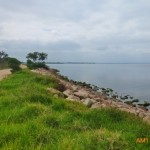UPDATE 2023 : it appears some of this never happened. Why ?
FOGL members gathered in 2016 at the Silt Jetties to hear from Parks Victoria’s Sean Phillipson, Manager for Regional Delivery, about plans to protect and rehabilitate this special part of the Gippsland Lakes.
As a stakeholder having had major projects along the Silt Jetties for ten years, FOGL was involved in workshops regarding their future and had input into the development of the current plans, so we were keen to hear how they are being implemented.
Sean showed us maps and gave an extremely interesting talk explaining the background to concerns about instabilities of the Silt Jetties and the importance of the south arm providing protection to the north arm, which is critical in protecting Jones Bay, identified under the International RAMSAR accord as an extremely important habitat for local and migratory birds, including endangered species. Without the Silt Jetties providing a physical barrier from wave action coming across Lake King, the bird habitat in Jones Bay would be in jeopardy, changing the freshwater conditions in this area. This reinforced the importance of the Silt Jetties, not as a tourist destination, but as an important structure to protect critical bird habitat. We then went for a walk where Sean showed us current works to stabilize the south arm with rock beaching. The old rock walling was ineffective in that it allowed waves to break over the rocks and wash away sand and earth behind the rocks and, as well, the rocks themselves washed away from the shoreline. Rock beaching is different, in that rocks are selected according to differing sizes and placed on a particular slope and in a manner that will protect the shoreline from incoming wave action by causing the waves to break before they reach the shore. Sean explained there is extensive research from river engineering that informs the design of the works and selection of an appropriate-size rock.
The rock beaching includes a self-launching toe that helps to keeping the rocks in place over time as the structure settles. Sean showed us rock beaching placed in an area where, in high winds large waves had the potential to break over the road from Eagle Bay into the Mitchell River, with potential to cause huge erosion and threaten the entire south arm. Salt-tolerant Phragmites have been planted behind the rock beaching.
As the works progress and the rock beaching is completed, plans are to restrict vehicle access to the last 2kms (from the composting toilet) to cars and motor vehicles and create a shared path for walkers and bicyclists. This will allow much of the land beyond the closure to be rehabilitated with appropriate grasses and shrubs, thereby providing much-needed habitat for our native fauna and providing better protection from erosion. Sean explained that the plantings are really the only way to protect the structure of the Silt Jetties into the future. As FOGL has been calling for this to happen for many years, we are delighted this is included in the plans.
It is important to note that the last 2kms will not be closed to use; only closed to cars and motor vehicles. Anglers will still be able to fish along this last 2kms, everyone will still be able to enjoy this special place and it will be even better without the cars – tranquil and more natural. Plans include upgrading the currently-used fishing spots along the Silt Jetties up to the road closure, with appropriate parking bays and possibly fireplace rings. Much discussion was had about the amount of litter left along the Silt Jetties, particularly at the popular fishing spots, toilet paper in the bush, ugly fire scars, removal of timber for fires and vandalism of trees. Also discussed was hoons in cars and the damage they do to the road surface while putting people and animals at risk along the road. Some FOGL members suggested appropriately large and noticeable signage was needed at the beginning of the gravel road asking people to drive slowly, refrain from making fires and take their rubbish away with them. Limitation on enforcing compliance was discussed.
It was a great morning – many thanks to Sean for his informative talk. As a major stakeholder, FOGL is keen to see these plans completed that will protect the Silt Jetties into the future.








